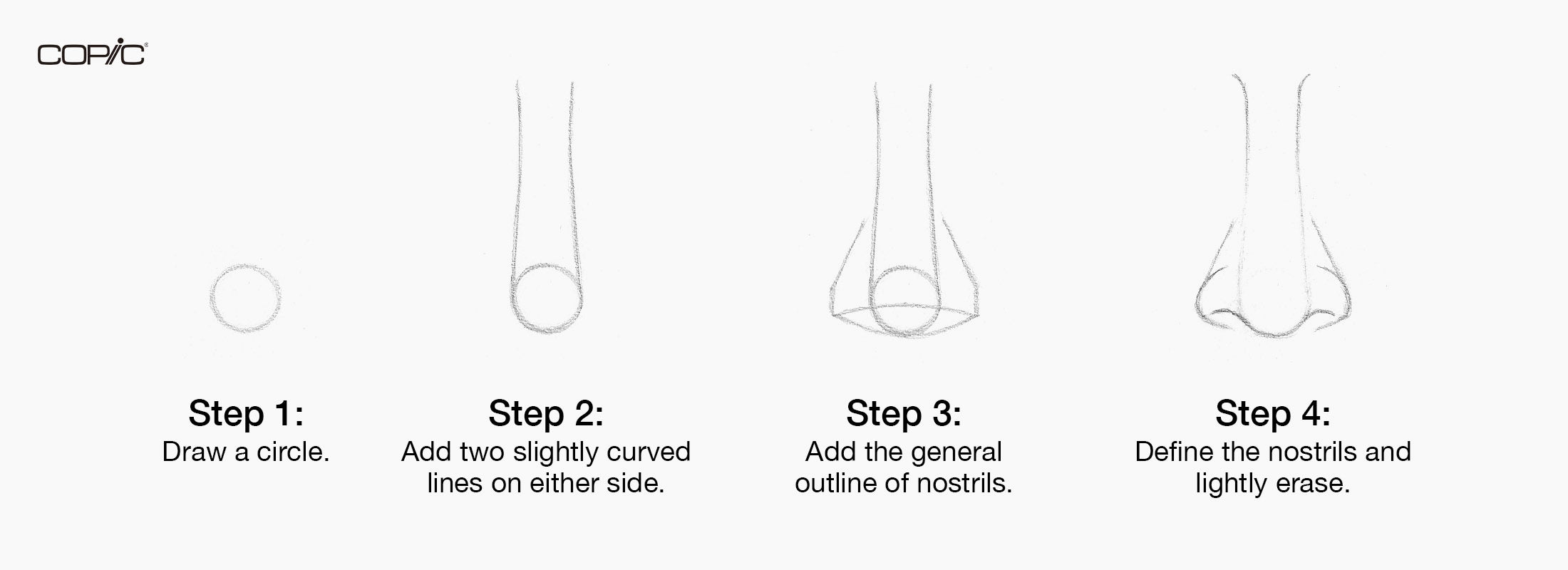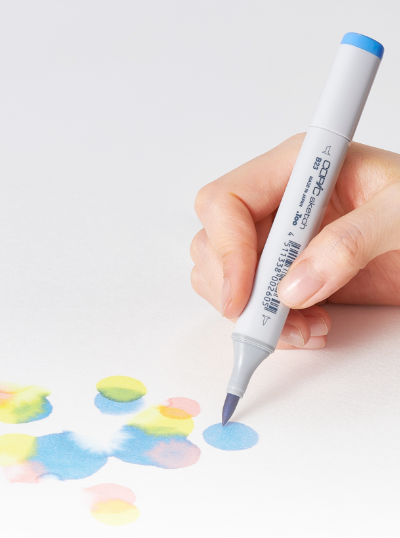Browns; how to color a NOSE
15-05-2022
Using Earth-Tones to Color Human Features
Today’s Feature: the NOSE!

In this blog, we’ll be showing you how to sketch and color another facial feature: the nose! Noses can be tricky, as they don’t have a definitive outline to them and can come in some rather odd shapes and proportions. But fear not! In this blog, we will show you how to color a basic nose from the front and the side view using your Copic markers! Once you’ve mastered a basic nose, it’s easy to tweak it to either be fuller, sharper, longer, etc. Conquering the basics goes a long way! And with that, let’s get started with the front view of the nose!

When you’re drawing a nose from the front view, it’s important to think about the basic shapes first. The tip of the nose is just a simple circle, and the bridge of the nose is a slightly curved open rectangle. With just those two shapes, you’ve already got most of the nose down! The last thing to add is the nostrils, and the best way to add this is to think about an upside down diamond shape with the top of the “diamond” at the bottom of the nose. Then, erase the tip of the diamond shape and you’ll see the nostrils. With that, you have a basic outline of the front of the nose!

The next step after drawing is of course, coloring. We recommend choosing 3-5 colors, depending on how big you’ve drawn your nose, and swatching the colors you think you want to use on a separate sheet of paper to make sure you’ve got what you want.

Then, begin by adding the darkest color first (E35). Next, use the mid-tone color (E33) to soften the darker one by shading the nostrils and the bridge of the nose. Flick the brush nib up and down for the tip of the nose and outward for the bridge area. Once you’ve added a few layers of your mid-tone color, use your lightest color (E31) to soften the blend. Repeat these steps as many times as you need and add any additional colors (in the image above, the artist added E02 in the final steps to get pinker skin) to reach the desired look you’re going for!

Now that we’ve shown you how to color the front of the nose with light brown colors, we want to show how a nose will look with darker tones! The above image follows the same steps as the first image, but with the E4_ colors. These earth-tones have a much darker, cooler undertone than that of the E3_ colors. There are 9 different Copic Earth-Tone groups, so be sure to look at each one when you’re trying to decide which ones to use!
Check out this blog on Copic Earth-Tones for a more in-depth look.

Next up, we have the side/profile view of the nose! This angle can seem tricky, but it’s honestly quite simple. Start off by drawing a vertical line and two circles; one a little larger and placed a bit higher than the other. Next, use the curve of that larger circle to create the profile of the nose, making sure the ridge of the nose goes slightly past the vertical line and curves back out. Next, add the nostril between the two circles in the lower area of the nose. Last but not least, erase the vertical line and circles, and you have a generic outline of the side of the nose!

In similar fashion to the front of the nose, you’ll now want to make some color choices off to the side or on a separate sheet of marker paper. We recommend either 3 or 4 colors like what we’ve shown above.

After you’ve decided on your colors, it’s time to start coloring! Begin with your darkest color first (E29 in this case) and add this color to the areas where you want to show depth. Next, add your mid-tone color (E27) to soften the areas around E29. *TIP: when coloring the side of the nose, don’t color straight up and down, color at an angle to make the shading look more realistic.
Next, use the lightest color in the group (E25) and shade over everything to create a smooth gradation. The last/fourth step is to add layers!! Repeat steps 1-3 at least one more time to achieve more contrast and smooth blends between colors.

Just like we did for the front of the nose, here is how you can color the side of the nose with lighter tones. In this example, the artist starts with E15, then E13, and finally E11. Notice how, by step 4, the nose looks a lot darker than how it begins. This is because of layering! So, if you want the skin of something you’re coloring to be very light, then use colors like E00, E000, and E0000. You’d be surprised at how fast even these very pale colors will get darker just by adding a few layers of it!

And with that, we wrap up this blog on how to draw and color basic noses! Print out the sheet above at home on marker paper or premium cardstock and practice with as many Earth-Tone combinations as you’d like! Share your noses on social media with us using the hashtag #copicwithus and tag us @copic_official_us.

In our next blog, we’ll be showing how to draw and color…lips! Until then!
Read More Articles
Copic Acrea on Canvas
How to use Acrea on various types of Canvas Hello Copic readers! In our previous blog, we wrapped up our discussion on how to use Acrea o...

The Best Papers for COPIC Acrea
How to Layer with Acrea on Various Types of Paper Hello Copic readers! In our previous blog, we wrapped up our discussion on how to use ...

Copic Acrea with Copic Ink
How can Acrea be used with Copic Ink? Greetings Copic readers! In our previous blog, we discussed how Acrea compares with Copic Multil...

Copic Acrea with Multiliners
How does Acrea compare with Copic Multiliner Pens? Greetings Copic readers! In our previous blog, we discussed how Acrea compares to the ...





